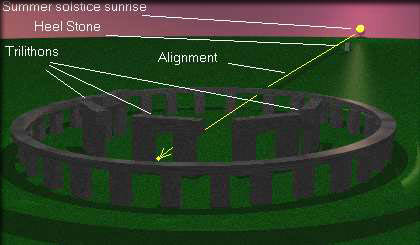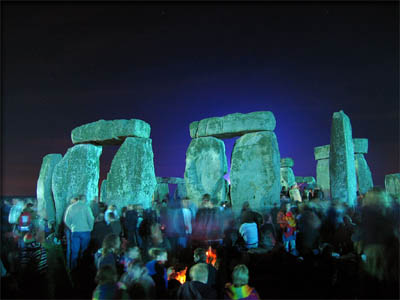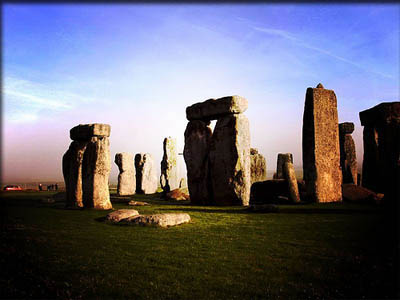 |
Stonehenge:
Mystery on the Salisbury Plain
|

Stonehenge, in many peoples' minds, is the most
mysterious place in the world. This set of stones laid out in
concentric rings and horseshoe shapes on the empty Salisbury
Plain, is, at the age of 4,000 years, one of the oldest, and
certainly best preserved, megalithic (ancient stone) structures
on Earth. It is a fantastic creation with the larger 25-ton
Sarsen (a hard type of sandstone) stones transported from a
quarry 18 miles away. Some of these boulders also carry massive
lintels connecting them. In ancient times, when all the stones
were standing, there was a ring of rock in the sky as well as
on the ground.
Who Built It?
|
Seven
Quick Facts
|
| When
Built: Earthworks and timber about 3100 B.C., first
stones 2600 B.C. |
| Heaviest
Stones: 50 tons |
| Made
of: Sarsen sandstone and Bluestone rock. |
| Design:
Upright stones and earthworks in a series of concentric
circles and horseshoe shapes. |
| Function:
Unknown, but researchers suspect it was used for ceremonial
and religious purposes. |
| Built
by: An unknown people without a written language. |
| Other:
Designed to be used for astronomical observations including
summer solstice. |
We know almost nothing about who built Stonehenge
and why. A popular theory advanced in the 19th century was that
the Druids, a people that existed in Britain before the Roman
conquest, had built it as a temple. Modern archaeological techniqueshave
dated Stonehenge and we now know that it was completed at least
1,000 years before the Druids came to power. If Druids used
Stonehenge for their ceremonies, they got the site secondhand.
Despite this, modern Druids have laid claim to Stonehenge. An
annual ceremony takes place at the ring of rocks during summer
solstice, one of the henge's astronomical alignments.
There is evidence that activity on the Stonehenge
site goes as far back as 11,000 years ago. It wasn't until about
3100 BC, though, that a circular bank following the current
Stonehenge layout appeared. At the same time pine posts were
put into place. Around 2100 BC stones started being erected,
at first the smaller bluestones, then the larger sarsens stones.
During this period some stones were erected, then later dismantled.
Why did the builders create, dismantle and rebuild
this isolated site? It's hard to say. They apparently didn't
have a written language and left no records. We can say one
thing about Stonehenge based on archaeological digs at the location.
There is almost no "trash." A number of pieces of flint, antler
picks or axes have been found, but very few items that one would
expect to see discarded at a human habitation This leads some
archaeologists to conclude that Stonehenge was "sacred ground,"
like a church. As one scientist put it Stonehenge was a "clearly
special place where you didn't drop litter."
|

Stonehenge
around 1500 BC. (Copyright Lee Krystek,
1997)
|
At about 1500 BC Stonehenge consisted of a circular
ditch with a raised bank on the inside. Within the bank was
a circle of 30 sarsen stones with lintels creating a raised
circle. Today only 17 of those stones still stand and few of
the lintels are still in position. Within the ring were five
"trilithons" (two massive upright stones supporting a lintel)
arranged in a horseshoe. On the open side of the horseshoe,
outside the ditch, was the heel stone, some 120 feet from the
ring. Once a year on summer solstice (the longest day of the
year), the sun will rise in alignment with the heel stone as
seen from the center of the ring.
In addition to the sarsen stones there was a less
elaborate set of blue stones that scientists believe were transported
to the site from Wales, 150 miles away. Some sit in a ring outside
the trilithons and the others in a horseshoe within the trilithon
horseshoe. There are also four "station stones" set in a rectangle
outside the ring. The station stones may have been used to predict
the movement of the moon.
Rings of Rock
Perhaps what is strangest about Stonehenge is
that it is far from being unique. Though Stonehenge is the most
intact and elaborate ring of stones, there are known to be over
a thousand remains of stone circles throughout the British Isles
and Northern France. Some of them were small, like Keel Cross
in County Cork which is just 9 feet in diameter. The largest,
Avebury covers over 28 acres and encircles what is now a whole
village. Some of the stones at Avebury weighed 60 tons.
|

A
modern summer soltice celebration at Stonehenge. (Photo
by Andrew Dunn licensed under the Creative Commons Attribution-Share
Alike 2.0 Generic license.)
|
How did the makers move these massive rocks many
miles? In 1136 in his History of the Kings of Britain
Geoffrey of Mammoth suggested that the movement of these huge
stones was done through the magic of Merlin the wizard. More
likely, however, the builders moved them by dragging them on
wooden sledges. Before the first one could be moved a road had
to be cleared from what was then a thick forest. Not an easy
job in itself, especially for a people who probably spent most
of their time and energy just fighting for survival. The construction
of both Avebury and Stonehenge must have been the work of many
generations.
The Corral Theory
Just as fascinating as how the builders constructed
the site is the question of why they created it. Archaeologist
Clive Waddington has suggested that the earliest henges, simple
ditches with surrounding mounds, may have been stock enclosures
for cattle. Remains of fence and gates found at the Coupland
Henge, which is more than 800 years older than Stonehenge, supports
his idea. Waddington thinks that when cattle were moved into
the enclosure during certain seasons, rituals were performed.
As time went on the circles functional aspect faded away and
they became purely religious structures.
Most of the rings were smaller than Avebury and
simpler than Stonehenge. While some of them had astronomical
alignments built into their design, many did not. This suggests
that their use as observatories may have been a secondary function.
A "Place of Healing?"
|

Professor
Geoffrey Wainwright thinks that Stonehenge may have served
as a "place of healing." (Photo by Dorieo21
licensed under the Creative Commons Attribution 2.0 Generic
license)
|
Another recent suggestion by Professor Tim Darvill
of Bournemouth University and Professor Geoffrey Wainwright
of the Society of Antiquaries of London is that Stonehenge may
have served as a "place of healing." Excavations of graves in
the area show that the remains of people buried there display
signs of serious disease or injury. Testing also indicates that
about half of those people were from outside the Stonehenge
area. "People were in a state of distress, if I can put it as
politely as that, when they came to the Stonehenge monument,"
said Darvill. Also puzzling is a large number of chips found
that were flaked off the bluestone of the monument. "It could
be that people were flaking off pieces of bluestone in order
to create little bits to take away… as lucky amulets," said
Professor Wainwright. The professors think that the place may
have been similar to Lourdes, the French shrine known for its
supposed ability to heal the sick. This evidence, however, does
not rule out other uses for Stonehenge. "It could have been
a temple, even as it was a healing center," Darvill said. "Just
as Lourdes, for example, is still a religious center."
Domain of the Dead or British Unification?
The area around Stonehenge has a large number
of burials and this has lead Professor Mike Parker Pearson of
Sheffield University to suggest that it is a domain of the dead,
while a Neolithic settlement nearby was the corresponding place
of the living. More recently, Professor Parker has championed
the idea that Stonehenge was built to unify the different peoples
of the British island. "There was a growing island-wide culture
-- the same styles of houses, pottery and other material forms
were used from Orkney to the south coast," says Pearson. "This
was very different to the regionalism of previous centuries."
Pearson also points out that a site as big as
Stonehenge would have required cooperation among many groups.
"Stonehenge itself was a massive undertaking, requiring the
labor of thousands to move stones from as far away as West Wales,
shaping them and erecting them. Just the work itself, requiring
everything literally to pull together, would have been an act
of unification," he explains.
So was Stonehenge a corral, a religious center,
a place of healing, or symbol of British unity? Or was it all
of the above? Scientists may never be able to say for sure.
As Professor Richard Atkinson of University College, Cardiff,
a researcher at Stonehenge, once said, "You have to settle for
the fact that there are large areas of the past we cannot find
out about..."
|
Stonehenge
at sunset. (Photo by Jeffrey Pfau licensed
under the Creative Commons Attribution-Share Alike 3.0
Unported license)

|

Copyright Lee Krystek
1997, 2012 . All Rights Reserved.